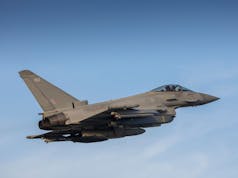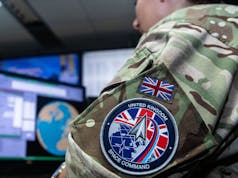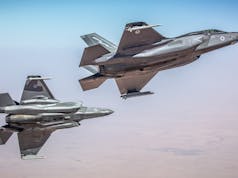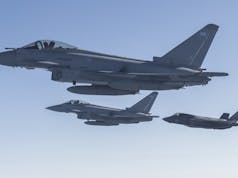The Ministry of Defence has awarded a £300 million contract to Ascent Flight Training to deliver the Future ISTAR and Rear Crew Training System (FIRCTS), significantly expanding aircrew training capacity for the Royal Air Force and Royal Navy, according to a press release.
The eight-year contract, managed by Defence Equipment and Support (DE&S), aims to quadruple the number of Mission Aircrew trained annually—from around 35 to 140.
These personnel will be equipped to operate advanced aircraft across global missions, including intelligence, surveillance, and reconnaissance roles. According to the MOD, this initiative will prepare aircrew for “the demands of modern worldwide operating environments” while reducing flying hours and environmental impact through increased use of simulated training environments.
Rear crew training will be delivered at RAF Cranwell and Royal Naval Air Station Culdrose using newly built facilities and cutting-edge simulation technologies. Lockheed Martin is responsible for delivering synthetic mission environments, Babcock will oversee the new infrastructure, and Draken will provide support for the upgraded King Air 350E Avenger aircraft used in training. Courseware will be developed at Ascent’s Bristol site.
The programme is also expected to bring economic benefits, with £180 million earmarked for the UK supply chain and around 68 skilled jobs created or sustained across Cornwall, Lincolnshire, and Bristol. Tim James, Managing Director at Ascent, said in the release: “We are so proud to once again be trusted by our UK MOD customers to deliver this innovative training solution across our operations sites in Cornwall and Lincolnshire.”
Rear Admiral Maria Eagle MP, Minister for Defence Procurement and Industry, described the contract as a milestone in defence training: “This significant investment represents important progress in preparing our Royal Navy and Royal Air Force personnel for the challenges of modern warfare.” She added that the deal supports both military readiness and the government’s broader economic goals.
Air Commodore Rob Caine, RAF Head of Flying Training, commented: “The investment in the latest training technology and infrastructure at RNAS Culdrose and RAF Cranwell will help us to prepare aircrew to be ready to Fly, Fight and Win in an uncertain world.”
Once qualified, personnel will operate aircraft including the RAF Poseidon MRA1, Rivet Joint, Wedgetail, Merlin Mk2, Wildcat helicopters, and Protector RG Mk1 remotely piloted systems. The FIRCTS initiative also marks a shift away from the older RCS1 training programme and is part of the wider UK Military Flying Training System (UKMFTS).
According to Air Vice Marshal Ian Townsend, the programme “will ensure the United Kingdom is at the forefront of providing world-class, operationally capable Air Power,” noting the increasing importance of aircrew skilled in electromagnetic spectrum operations and decision-making in complex battlespaces.
Richard Curzon, Senior Responsible Officer for Air Capability Delivery, said: “The enhanced provision will see a step change in training quantity and quality… ensuring the UK maintains the absolute best sovereign capability to meet emerging threats and challenges.”
The first cohort of trainees is expected to begin using the new system in 2027.
IMAGERY BABCOCK COPYRIGHT.














This is fantastic news and now we can expect many new aircraft as a result.
“Chocs away chaps”.
We can hope it’s a vital foundation stone for restoring mass.
I hope the SDSR is going to announce an increase in fast jets.
I would like to see the RAF restored to a sensible 12 fast jet squadrons and the FAA restored to 4.
Perhaps a ‘mid/ high’ mix of Tempest, F35A and F35B.
RAF
8x Tempest Squadrons
4 x F35A Squadrons
FAA
4 x F35B Squadrons.
All underpinned by a Carrier capable UCAV pool, to be deployed between the FAA and RAF as required.
I would be happy with 12 front line fast jet squadrons total as an ambition. Around 80 f35b providing 4 squadrons and 140 typhoons providing 8 squadrons would be a good starting point.
If they do increase the numbers it will be interesting to see how. Do they go European typhoon to avoid reliance on the US or go for more f35b or even the model.
Kinda feels like in the age of beyond visual range air combat that stealth is likely far more important than agility but equally lift potential for acting as a missile truck is important.
My gut is they will go for a F35b and typhoon buy as they need both.. 4 squadrons of F35b are needed to maximise the carriers but in reality it’s the typhoon squadrons that will take the heavy lifting of any future war as f35 will now not mature until the 2030s and it’s the typhoon that carries all the precision munitions including the 700+ cruise missiles in our arsenal.
The only question is would it be polictically difficult right now to order more f35, considering the whole trump mess
Ordering 25 more Typhoon makes sense as RAF already has mass and pipeline and it creates UK jobs. It will be easy for them to add mass with the newest version and will enable the remanufacturing on the T2 frames to T4 spec so the fleet is fully unified.
It is also more than enough to aircraft to deal with Mad Vlad’s scrap heap challenge.
Ordering the next small bath of 25 (ish) F35B also makes sense as it makes the F35 force usable across two tasking although it should be tied to a mass and periodicity of carrier deployments.
Even if the order is conditional on verily things being achieved.
So I see a split buy on the horizon.
ditto Jonathan !
Mmmmm is Maria Eagle a Rear Admiral??????
You beat me to it, Laurence!
and me
And yet, I read there is no expansion on the 4 Avenger aircraft used at Culdrose for the task. Why?
Because the new provision is done through simulators. More time in simulators means less time needed in/with actual planes, so greater training throughput per plane. Fourfold, apparently. Probably would be a bad move for pilots, but possibly a valid strategy for rear crew.
The P8s don’t even have windows, so I imagine synthetic sensor outputs will be a pretty close substitute for the actual role.
Can’t simulate doing it in a maneuvering airliner, though.
No mention of pilots though.
I know the Royal Navy Isn’t In a great place after years of cuts… But are we seriously going to see a bootneck handing command over to a Labour MP In a few years?! 🤪
This programme has slipped significantly to the right with the current training contract extended to June 2026 so a further extension will be required until these facilities are physically built, fitted out, tested, commissioned and handed over.
Cranwell is a smaller project and should be handed over first but 2027 is still a push.
Another example of glacial paced procurement and any increase in numbers will not be seen in the front line at best until 2028.
I sincerely hope that promoting the Procurement Minister ‘Maria Eagle’ to Rear Admiral is an editorial slip-up and not wishful thinking by the PM.